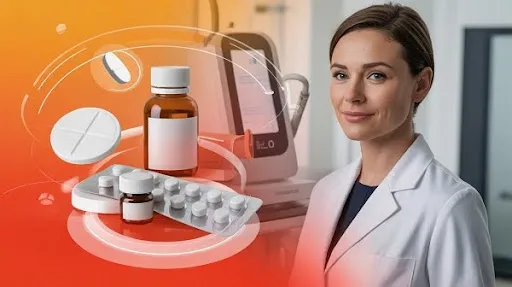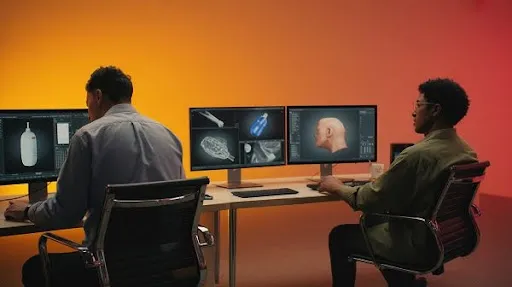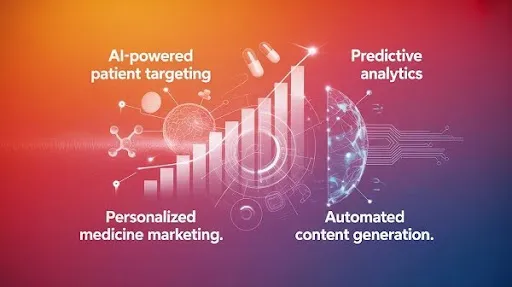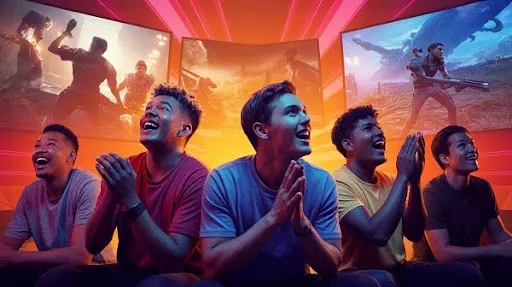A shift is happening in pharma marketing, and it’s not a quiet one. The old playbook built on brochures, reps, and static promotions is fading fast.
Pharma brands that used to depend on routine outreach now face patients who demand clarity, healthcare professionals who expect meaningful content, and a digital space that rewards engaging visuals over traditional pitches.
The next wave of pharma marketing trends isn’t subtle. It’s bold, visual, and built around experiences that actually teach something.
Pharmaceutical companies are now under pressure to stand out in a space filled with claims, screenshots, and surface-level education. Anyone can talk about features. The ones who win are the ones who show, explain, and connect. That’s where studios like Prolific Studio come in, mixing creativity, accuracy, and science-backed communication to help brands stay ahead.
This blog breaks down what’s shaping the new era of pharma marketing and why brands need to build strategies that are ready for the future, not just the next quarter.
The Rise of Visual-First Communication in Pharma Marketing Trends
Those in the healthcare profession are often busy and do not appreciate the burden of having to read long, dense explanations to understand a complex medical concept. Brands need simple, sharp, and visual communication. That’s why pharmaceutical products animation, 3D explainers, and animated breakdowns have become essential tools.
A strong video marketing strategy does more than entertain. It makes complex science easy to understand, which gives HCPs and patients more confidence in what a therapy offers. It also gives pharmaceutical companies a chance to talk about their products without overwhelming their audience.
Why visuals are now standard, not optional
- Videos increase engagement across every channel.
- Animated videos for marketing keep attention longer than static graphics.
- Patients understand procedures faster when they see them in motion.
- HCPs appreciate concise demonstrations that save time.
This shift sets a new benchmark. Brands that only rely on traditional content start to appear outdated, while companies using pharma brands animation stand out as more modern and patient-friendly.
The New Era of Pharma Marketing
Trust has always shaped the pharmaceutical industry. But now, trust isn’t built through long-form brochures or formal presentations. It’s built through meaningful explanations, transparent messaging, and content that leaves no room for confusion.
This is where medical animation services make a major impact. They help brands translate big scientific ideas into straightforward visuals. A therapy’s journey through the body becomes a story. A complex disease process becomes understandable. A treatment plan feels less intimidating.
How clarity impacts pharma marketing strategy
- People follow instructions better when they understand the “why.”
- Doctors prefer content that respects their time and gives the facts quickly.
- Regulatory teams get more confidence when content stays accurate.
A modern pharma marketing strategy isn’t about throwing information everywhere. It’s about creating pieces that actually stick.
Pharma Marketing Trends Shaped by Personalization and Real Engagement
Personalization isn’t new, but in pharma, it’s finally becoming practical. Though it is not easy, rather than sending the same mass message to everyone, brands can now discontinue the practice and tailor messages to real, unique needs.
The future belongs to companies that understand how audiences think and respond.
What personalization looks like today
- HCPs get content based on their specialty or interest.
- Patients see more useful education instead of one-size-fits-all messaging.
- Brands collect feedback that guides the next step in communication.
Personalization doesn’t require flashy tools. Even animated videos for marketing can be customized for different groups. A single video can be cut into multiple segments based on what matters most to each audience. That’s the kind of smart communication the market expects now.
Why 3D Product Animation Services Are Reshaping Pharma Branding
When someone sees a 3D model of a device or therapy, the idea becomes real in a way text can’t match. 3D product animation services help pharmaceutical companies show the inside of a process they couldn’t normally display.
A 3D breakdown can illustrate how a drug interacts with cells, what a device looks like inside the body, or how a therapy reduces symptoms. These animations don’t just explain. They elevate the brand. They make the product look premium, reliable, and advanced.
Common uses of 3D animation in the pharmaceutical industry
- Mechanism of Action videos (MoA)
- Product launch visuals
- HCP training
- Patient education
- Investor presentations
This form of content creates a level of understanding that text-based explanations struggle to match. That’s why 3D animation services are now one of the strongest tools in successful pharma marketing.
The Growing Role of Experimental Animation and Storytelling in Pharma
Scientific messaging used to be stiff and overly serious. It still needs accuracy, but audiences respond far better to stories. That’s where experimental animation comes in, a mix of science, design, and emotional connection.
A strong narrative paired with animation can shift how people feel about a condition or therapy.
Storytelling in pharma changes the impact of a message
- It creates emotional clarity.
- It helps patients see themselves in the treatment journey.
- It turns HCP education into something memorable, not forgettable.
The pharmaceutical industry often avoids emotional approaches out of fear of oversimplifying science. But animation allows brands to stay accurate while making the message more inviting and human.
Pharma Marketing Trends Driven by Immersive Experiences
Digital connectivity is no longer restricted to a traditional screen. Pharma teams are developing virtual reality, interactive apps, and immersive content. This is not about flashiness. It’s about creating learning experiences that feel hands-on without physical equipment.
HCPs can walk inside a 3D model of a disease pathway. Patients can understand their treatment steps through interactive sequences. These experiences give audiences a level of clarity they’ve never had before.
Leading brands are pulling them from the shelf right now. The market is proving that Immersive content is a pillar of successful pharma marketing.
Consistency Across Channels
Pharma companies no longer rely on a single outreach method. The audience, along with their expectations, is now on multiple platforms. A strong strategy ensures that messages feel consistent, but not copy-pasted.
- Video snippets for social media.
- In-depth 3D explainers for portals.
- Short animations for email campaigns.
- Interactive visuals for conferences.
The brands that win are the ones that adapt their video animation agency assets for every channel without losing the core message.
This approach keeps campaigns fresh and easy to engage with.
Data-Driven Decisions Backed by Real Content Performance
In the past, pharma teams measured success through broad assumptions. Data from videos provides real-time feedback on behavioral change, viewer drop-off, and the most engaging content.
This makes the entire process more efficient. No guesswork. No outdated formats. Teams spend their resources on content that gets results.
Data doesn’t replace creativity. It strengthens it. It shows which pieces connect with audiences and what needs more clarity. This is the backbone of successful pharma marketing today.
How AI Fits into Pharma Marketing Trends
AI is renegotiating the outdated definition of task automation. Trends enable Pharma brands to help HCPs and patients interact with structured AI content and deliver the right message to the right audience.
For instance, AI can determine which sections of an animated video a doctor is most engaged with and which segments help patients adhere to their treatment plan. Brands can use this insight to tweak videos or materials quickly, making a video marketing strategy far more effective.
Ways AI Helps Pharma Marketing
- Suggests what content doctors or patients will find most useful.
- Shows what parts of a video get the most attention.
- Helps check content for regulatory compliance before publishing.
- Guides campaigns to perform better across emails, websites, and social media.
When AI is combined with 3D product animation services or pharmaceutical products animation, it allows content to be both precise and engaging. This approach is increasingly important for winning pharma marketing campaigns.
Immersive Experiences with AR and VR
Augmented and virtual reality are no longer just flashy tools. They give audiences interactive ways to learn. Patients can see how a therapy works in their body. HCPs can train in a virtual space without needing real equipment.
These experiences are especially useful for rare diseases or complex therapies. Pairing experimental animation with AR/VR makes learning visual and memorable.
Popular Uses of Immersive Content
- VR modules for HCP training on new treatments.
- AR visual guides for patients showing how the medication works.
- Interactive 3D demos for investors or partners.
Brands using these tools often see higher engagement. Immersive content is becoming a must in the new era of pharma marketing.
Patient-Focused Campaigns That Work
Pharma marketing today isn’t just about visibility. It’s about creating real connections with patients. Brands that explain treatments clearly and visually help patients follow through with care.
Using pharma brands animation or interactive stories, complex processes or therapy routines can be simplified.
Steps to Make Patient-Centric Campaigns
- Highlight important steps in treatment and recovery.
- Use visuals to clarify tricky procedures.
- Ask patients for feedback to improve content.
- Share content consistently across channels.
Understanding the customer and providing them with these patient-focused options are fundamental to successful marketing in pharma.
Telling a Story Across Multiple Channels
A pharma marketing strategy is only strong if it connects across all touchpoints. Patients and HCPs encounter content on social media, websites, emails, webinars, and portals. Consistency matters.
Brands can reuse animated videos for marketing across different channels. Shorter clips for social media, full animations for portals, and interactive visuals for events. The story remains the same, but the format fits the audience.
How Omnichannel Storytelling Helps
- Videos on portals can be trimmed for social media.
- VR or 3D content can support conferences and online training.
- Insights from the engagement guide on which content goes where.
A cohesive strategy keeps the pharma marketing landscape relevant and engaging everywhere.
Measuring Engagement with Visual Analytics
It’s not enough to count views. Brands now track how viewers interact with content. Which scenes are watched repeatedly? Which parts cause drop-off? This shows what works and what needs improvement.
For instance, a series of 3D animations explaining a therapy can highlight which points HCPs focus on most. Brands can then clarify or emphasize key messages.
Visual analytics makes content smarter. With medical animation services, brands show not just understanding but action, how well the audience learns and applies information.
Working with a Video Animation Agency
Video animation agencies partner with you to provide assistance that your internal marketing may lack. They can develop materials that are both scientifically accurate and engaging to viewers. Services include:
- 3D animation services for product demos.
- Pharmaceutical products animation for patient education.
- Experimental animation for awareness campaigns.
- Branded explainer videos for HCPs.
Pharma brands that invest in professional animation see stronger engagement and recall. These tools are central to winning pharma marketing strategies.
Frequently Asked Questions
Which visual tools work best in pharma marketing?
They include 3D animations, animated marketing videos, VR/AR simulations, and use visual storytelling. They simplify complex issues, resulting in high memorability and retention.
How does a video animation agency help pharma companies?
They also create 3D product animations, experimental animations, and custom content, which make campaigns more accurate and engaging.
Why is patient-focused marketing important?
Visual, clear, and personalized content improves understanding, adherence, and trust, which supports better outcomes.
Can AI replace creative teams?
AI helps optimize content and predict engagement but does not replace creative work. The best campaigns combine AI insights with professional animation.
How do brands stay compliant while using videos?
Scripts, visuals, and claims are reviewed carefully. Medical animation services make complex info clear without risking accuracy.
Which channels are most effective for campaigns?
Multi-channel strategies work best: social media, email, portals, webinars, and conferences. Consistency is key.
Final Words
They know in pharma, it is all about comprehension, and that marketing is not simply the dissemination of information. It is clear to those who use storytelling, AI-driven personalization, and immersive experiences that they know the direction to go with marketing in pharma to build a strong, sustainable model.
Prolific Studio is one of the foremost pharma animation agencies, helping pharma organizations translate complex scientific concepts into engaging animated content. Pharma companies can utilize these experimental animations and interactive storytelling to engage both HCP and patients.
Investing in simple, creative, and entertaining animations is a must if your brand is aiming to excel in pharma marketing in this new age. Converting, inspirational, and educational content is essential for brands to build trust through effective communication.
Related Articles:









